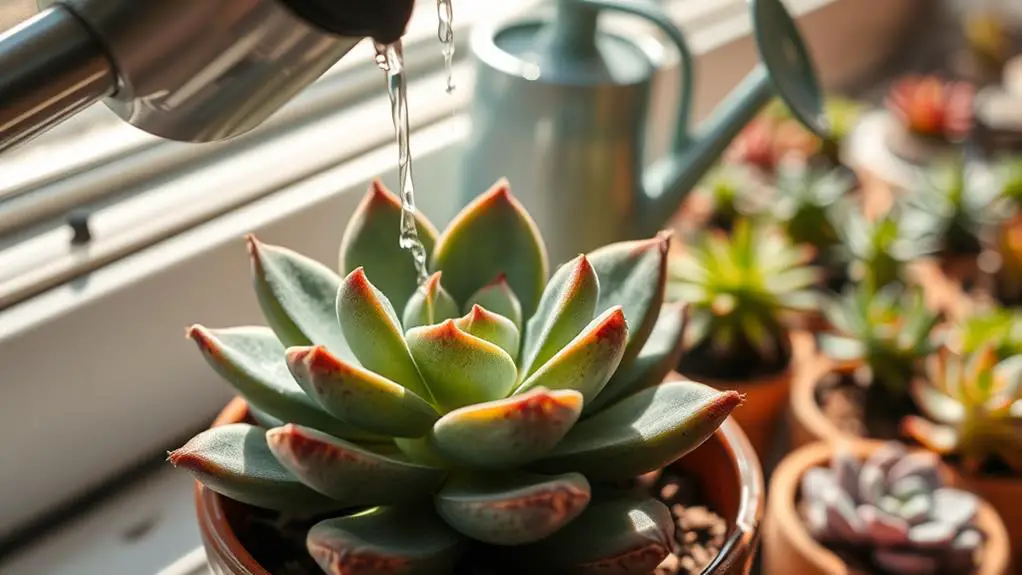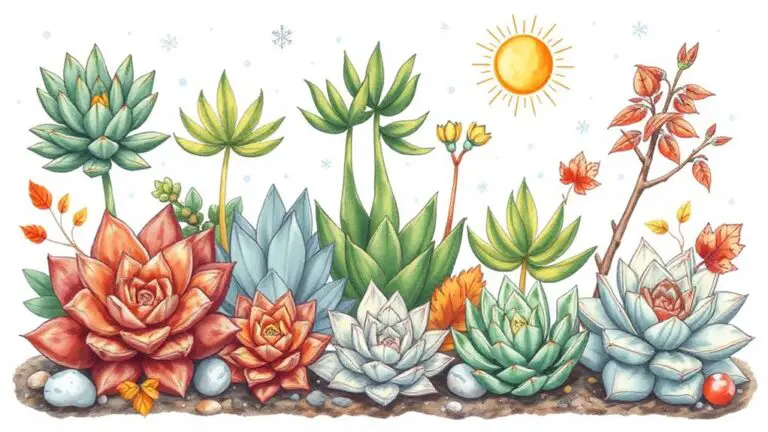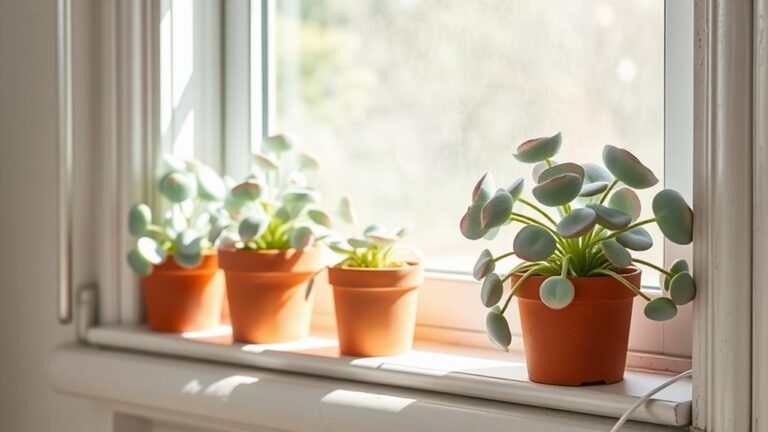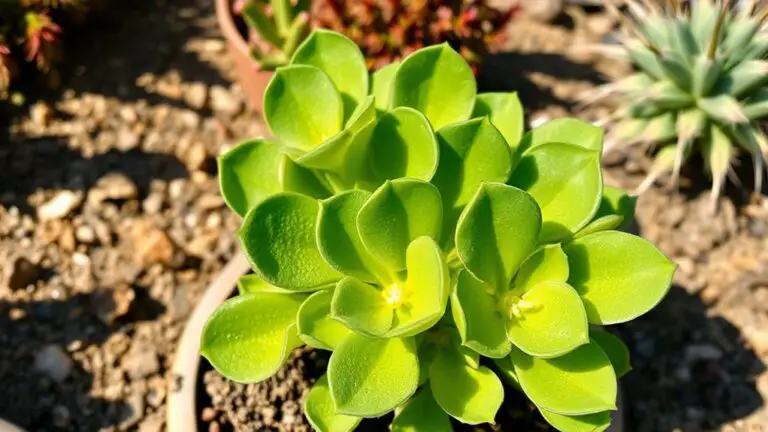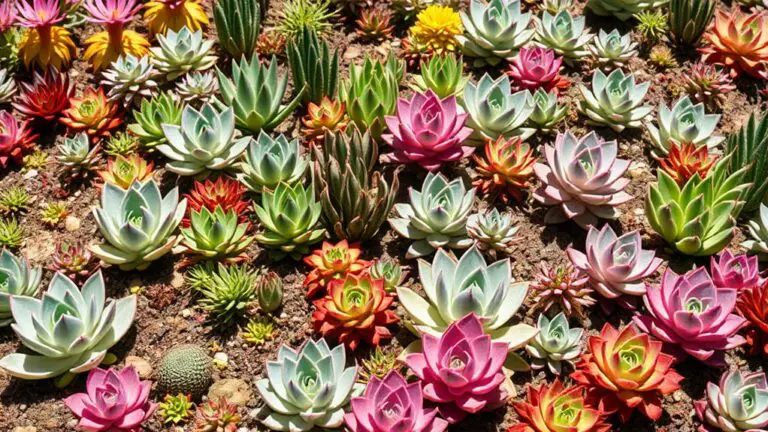Save Your Underwatered Succulents With This Step-By-Step Guide
Are your succulents looking less than vibrant with crispy, wrinkly leaves and parched soil? Don't worry; you can bring them back to life. This guide will walk you through the precise steps to rehydrate and revitalize your dehydrated plants. Starting with soaking the plant to ensuring a well-draining soil mix, you'll learn how to restore your succulents and keep them healthy. Curious about the exact techniques to transform your thirsty plants back into thriving greenery? Let's get started.
Identifying Underwatered Succulents
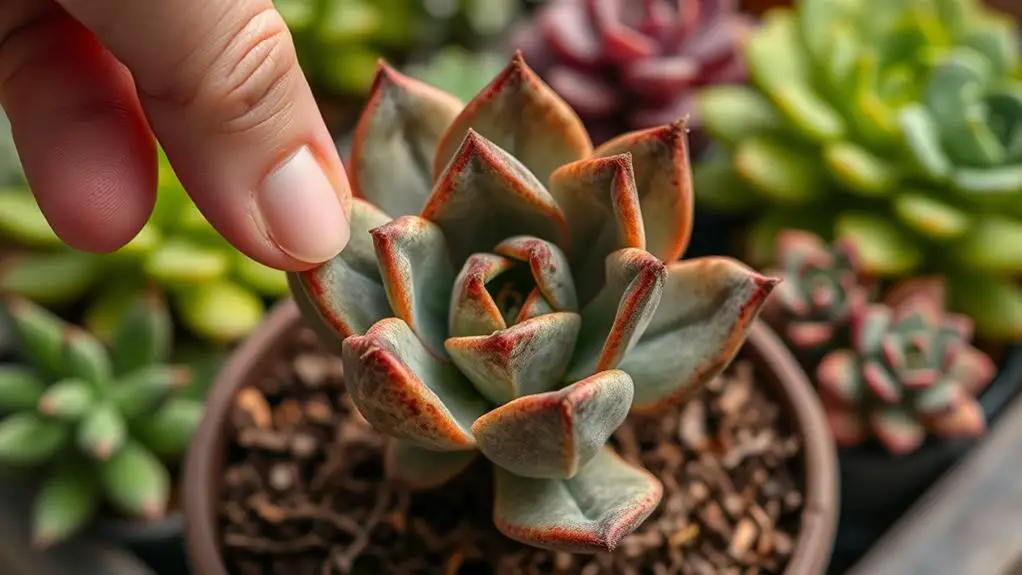
When you suspect your succulent is underwatered, it's crucial to look for specific signs that indicate dehydration. One of the first things you'll notice is that the leaves become crispy, wrinkly, and shriveled. These changes happen because the succulent isn't getting enough water to keep its leaves full and healthy. When the plant doesn't have enough moisture, it starts to show stress.
Another sign is brown edges on the leaves, especially at the bottom. These brown edges are a clear signal that your succulent is lacking the water it needs. Sometimes, you'll see aerial roots forming. These roots grow above the soil as the plant desperately searches for moisture from the air.
Check the soil, too. If it looks dry and crumbly, it's another sign your succulent is underwatered. Healthy soil should retain some moisture, but if it's completely dry, your plant isn't getting enough water.
Also, underwatered succulents often grow slower and may not flower during blooming seasons.
Signs of Dehydration
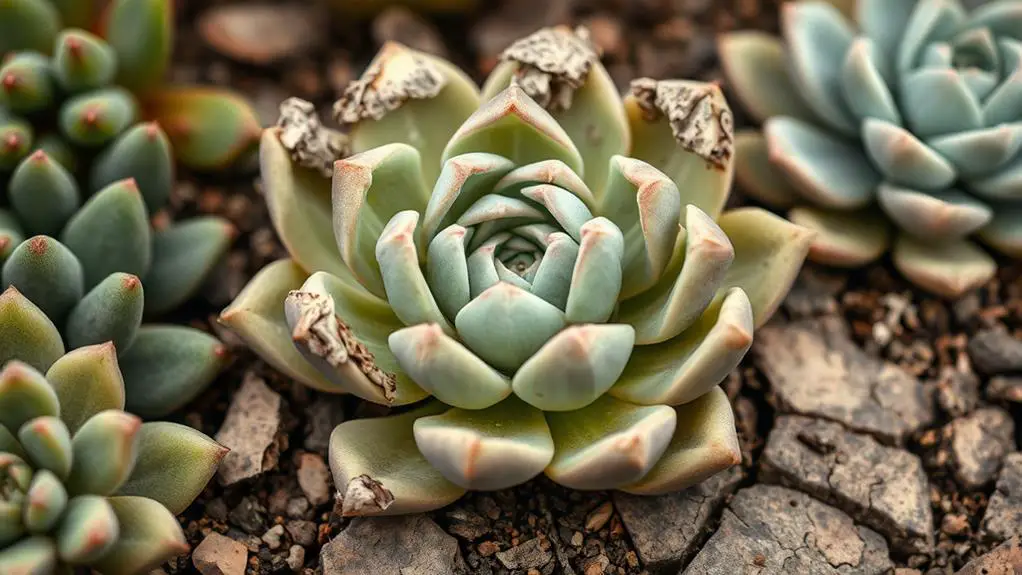
Recognizing the symptoms of an underwatered succulent is just the beginning; understanding the specific signs of dehydration will help you take corrective action swiftly.
When your succulent starts showing crispy leaves, that's a clear sign it's craving water. These leaves may feel brittle to the touch and look shriveled.
Wrinkly leaves are another indicator, as they signify the plant's internal moisture is depleting.
Look closely at the lower leaves. If they've brown edges, your succulent is definitely dehydrated.
Slower growth and a lack of flowering during its blooming season are also significant signs of dehydration.
Succulents often develop aerial roots when they're desperately seeking moisture from the air, which means the soil isn't providing enough water.
Speaking of soil, check if it looks dry and crumbly. Proper moisture retention is essential for your succulent's health.
Dry soil is a telltale sign that your plant isn't getting the hydration it needs.
By understanding these signs of dehydration, you can act quickly to save your underwatered succulents.
Pay attention to these symptoms, and you'll be well on your way to restoring your plant's liveliness.
Initial Rehydration Steps

Taking the first steps to rehydrate your succulent involves more than just a casual watering; it's vital to thoroughly soak the plant to guarantee moisture reaches deep into the root system.
Start by placing your underwatered succulent in a container and filling it with water. Let it soak for several hours. This initial rehydration step guarantees that the roots get the moisture they desperately need.
After soaking, allow the soil to absorb the water. You may need to repeat this process until you see water draining from the pot's drainage holes. This step is significant because it indicates that the roots are well-hydrated.
Be sure to let all excess water drain out to avoid soggy soil conditions, which can lead to root rot.
Once you've completed the thorough soak, monitor the plant over the next 3-4 days. Look for signs of recovery, such as the leaves firming up and visible new growth.
If the succulent still appears extremely dehydrated after this period, you might need to evaluate more intensive water therapy.
But for now, focus on these initial rehydration steps and be patient. Your succulent is on its way to recovery!
Water Therapy Techniques
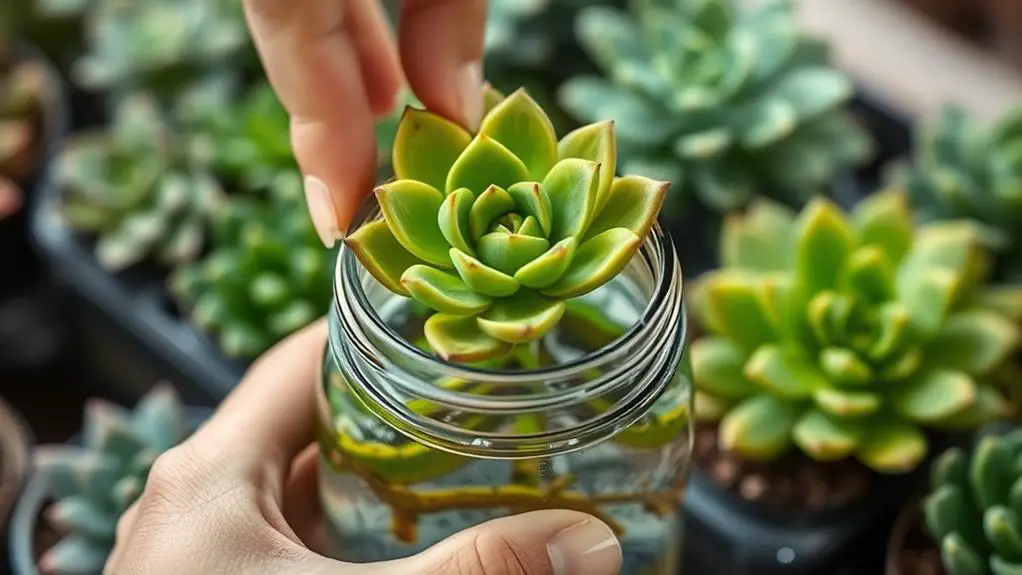
To help your underwatered succulents bounce back, you can use water therapy by soaking the entire pot in water.
This deep soaking method guarantees the soil absorbs moisture through the drainage holes, rehydrating the roots effectively.
Remember to let the pot drain completely after soaking to prevent waterlogging and keep an eye on your plant for signs of improvement.
Deep Soaking Method
One effective way to revive severely underwatered succulents is the deep soaking method. This technique involves submerging the pot in water until the soil absorbs enough moisture that it starts draining from the bottom. The goal is to guarantee that the roots are thoroughly rehydrated.
To start, you'll need a container large enough to hold your succulent pot. Fill it with water and place the pot inside, making sure the water level reaches just below the rim of the pot. Let it sit for about 10-15 minutes, allowing the well-draining soil to absorb the water. This method should be done every one to two weeks for severely underwatered succulents to help them recover and prevent root death.
After soaking, make sure your pot has proper drainage to avoid waterlogging, which can lead to root rot.
Once your succulent is soaked, place it in indirect sunlight. This reduces stress while it recovers. Monitor the soil moisture levels regularly, adjusting your watering schedule to meet the plant's needs.
With patience and consistent care, your underwatered succulent will thrive again. Remember, the deep soaking method is a powerful tool in your plant care arsenal, helping your succulents recover and flourish.
Submersion Technique Tips
Utilizing the submersion technique, also known as water therapy, can be a lifesaver for severely dehydrated succulents. To start, fully submerge the pot containing your underwatered succulent in a soak of water for 30 minutes to an hour. This allows the roots to absorb the much-needed moisture.
Make sure that the water level is above the soil line but doesn't cover the leaves. This prevents rot and fungal issues.
After the soaking period, let the pot drain thoroughly. This step is essential to prevent waterlogging, which can lead to root rot if the soil stays too wet. You might need to repeat this soaking process every one to two weeks for severely dehydrated succulents.
Keep an eye on your plant for signs of recovery, like firm leaves and new growth.
Once you've completed the water therapy, monitor the plant closely. Place it in indirect sunlight to reduce stress and encourage healthy rehydration. This allows the plant to recover in a more controlled environment.
With patience and care, your underwatered succulent should bounce back, looking healthier and more vibrant than before.
Preventing Underwatering
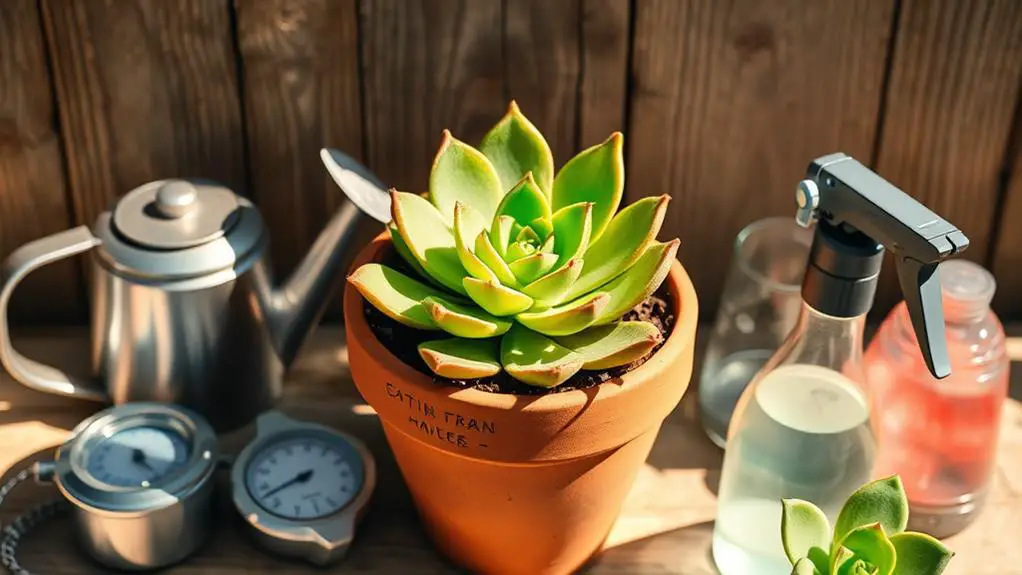
Establishing a consistent watering schedule is crucial to prevent underwatering your succulents. Start by setting up a regular watering routine that adjusts with the seasons. In warmer months, you'll need to water your succulents more frequently. During cooler months, reduce the frequency. This helps your plants stay healthy and hydrated.
Use plant care apps like Waterbug or Planty to get reminders to water your succulents. These apps can help you keep track and avoid neglect.
Checking the succulent soil is also critical. Make sure it's well-draining to prevent root rot. You can increase humidity levels around your succulents with humidity trays or misting. This helps retain moisture and prevents dehydration.
A moisture meter is a great tool to regularly check the soil's moisture levels. This way, you'll know exactly when to water your succulents, avoiding both underwatering and overwatering.
If your succulent becomes rootbound, it can quickly dry out. While repotting is important, we'll discuss the best practices for that later.
Following these steps will help you keep your succulents thriving. By being attentive and proactive, you'll guarantee your plants get the right amount of water they need.
Repotting Best Practices
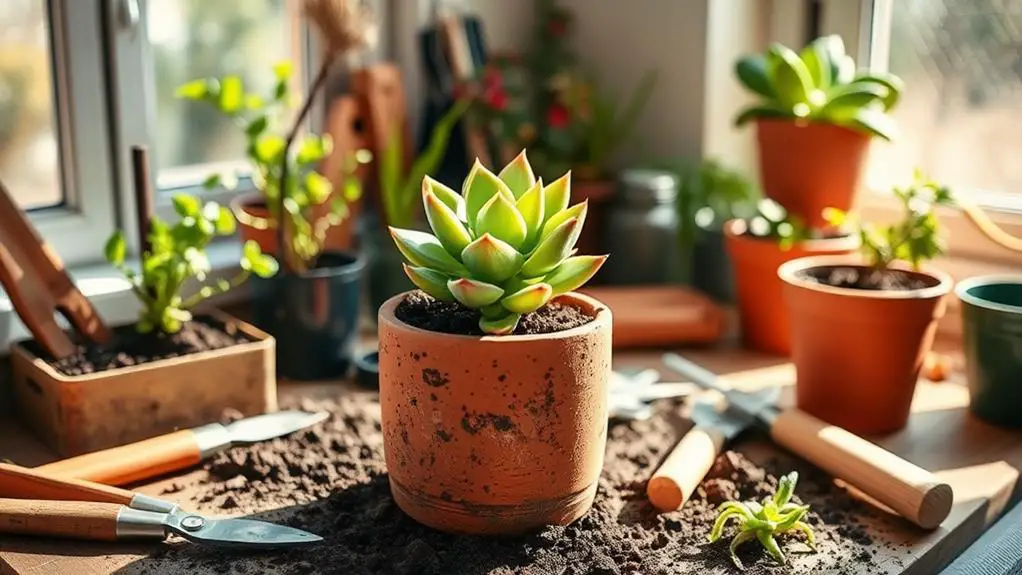
Repotting your succulents is an important step in maintaining their health and vigor. Start by choosing a pot that's about 10% larger than the current one. This gives the roots ample space to grow and prevents the plant from becoming rootbound, which can lead to underwatering issues.
Next, use a well-draining soil mix designed for succulents. A good mix includes 3 parts soil, 2 parts barn fines, and 1 part pumice or perlite. This combination helps retain the right amount of soil moisture without causing root rot.
When you repot, make certain the new container has adequate drainage holes. These holes let excess water escape, keeping the soil from becoming too soggy.
After repotting, allow your succulent to acclimate by placing it in indirect sunlight for a few days. This helps reduce transplant shock and encourages healthy growth.
Keep an eye on the soil moisture and adjust your watering schedule as needed. It's vital to get the balance right—too much or too little water can harm your succulent.
Soil and Moisture Management
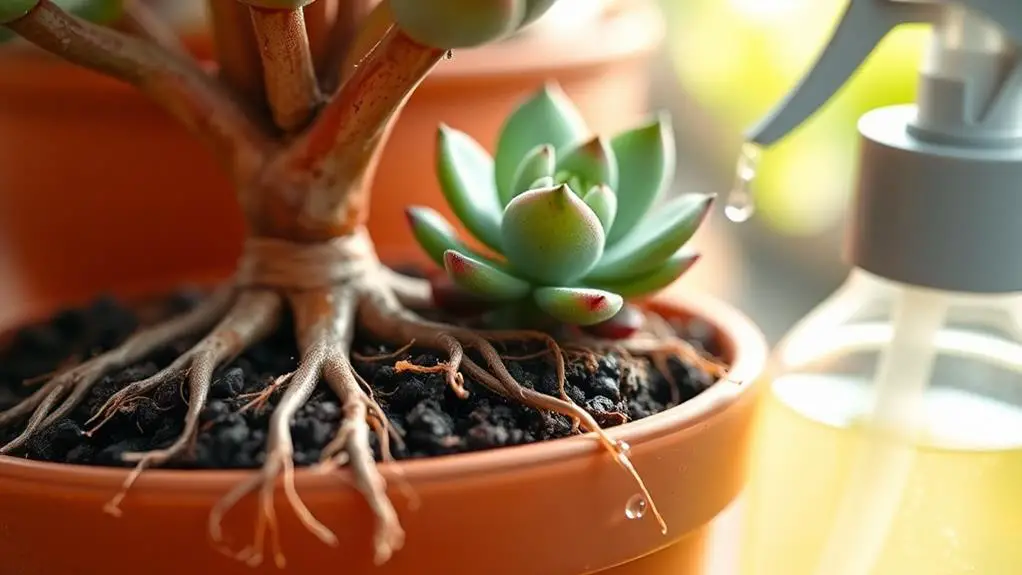
Once you've repotted your succulents, managing soil and moisture becomes the next priority.
It's essential to choose the right potting soil mix designed for succulents and cacti. Aim for a composition of 3 parts soil, 2 parts barn fines, and 1 part pumice or perlite. This mix provides excellent drainage and moisture retention, important for preventing root rot.
Using soil moisture meters is a smart way to monitor soil moisture accurately. These handy tools let you know exactly when your succulents need watering.
Check the top inch of soil regularly; it should be completely dry before you water. This practice helps avoid overwatering, which can lead to soggy soil and unhealthy roots.
Make sure your pots have drainage holes. These holes allow excess water to escape, preventing water from sitting at the bottom and causing root issues.
Every succulent species has different needs, so adjust your soil composition accordingly. Some succulents need more moisture retention, while others prefer drier conditions.
Environmental Considerations
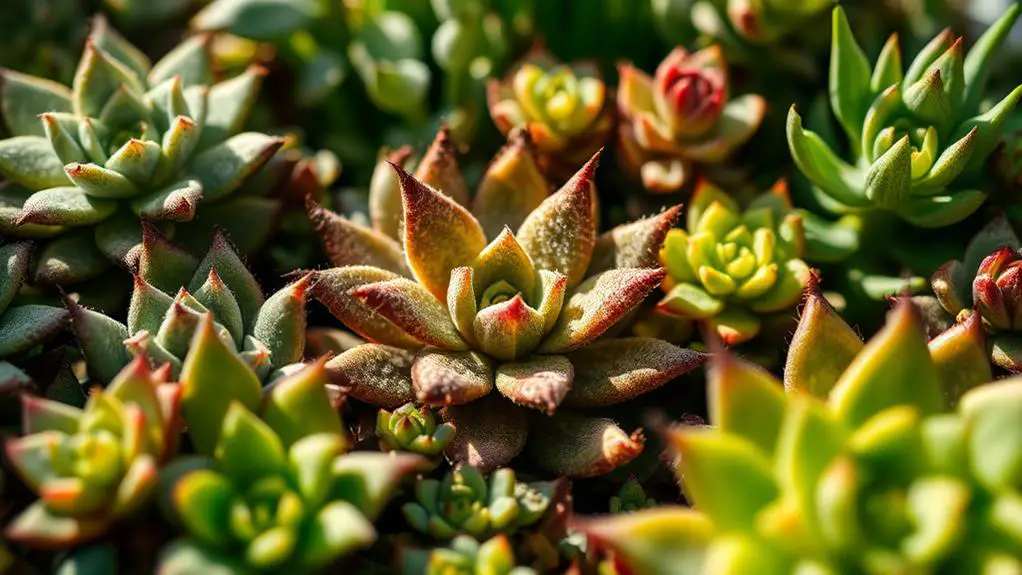
Taking care of succulents isn't just about soil and watering; understanding their environmental needs is essential too. High temperatures can cause water to evaporate quickly, especially if your succulents are in direct sunlight or near heat sources. This can make them dry out faster than you might expect.
To prevent this, place your succulents where they can get bright indirect light instead. They'll get the sunlight they need without the risk of drying out too quickly.
Humidity levels also play a big role in how often you need to water your succulents. In low humidity environments, succulents lose moisture faster, so it's important to monitor these conditions and adjust your care routine.
If you notice the air is particularly dry, you might need to water a bit more frequently.
The type of container you use can also affect moisture retention. Clay pots tend to dry out more quickly than plastic ones.
Consider switching to plastic pots if you struggle with keeping your succulents hydrated.
Lastly, be aware of seasonal changes. Warmer months require more frequent watering, while cooler months may necessitate less.
Seasonal Watering Adjustments
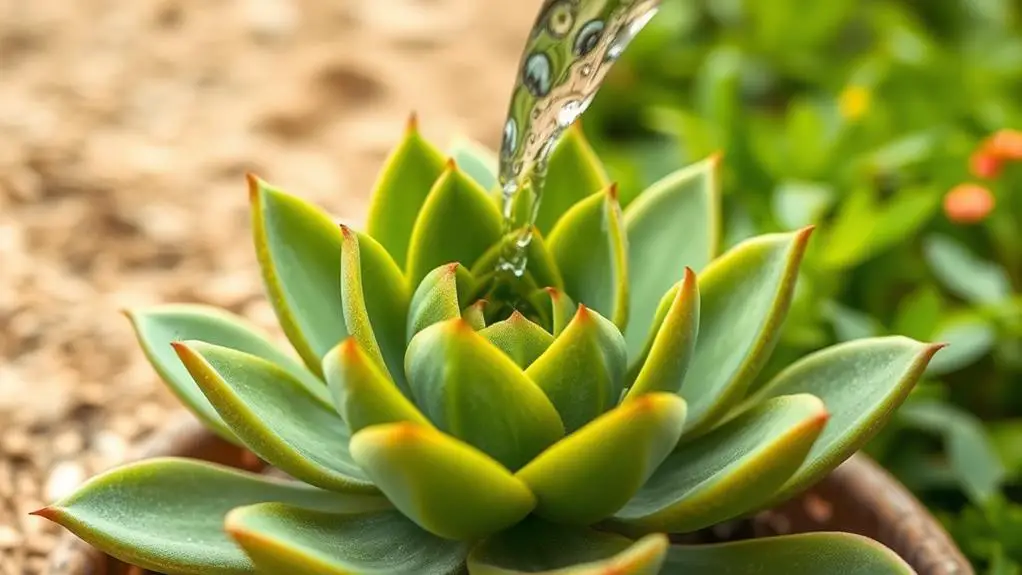
As the seasons change, so do your succulents' watering needs. Seasonal changes can notably impact how often you should water.
In the colder months, succulents generally require less frequent watering. You might only need to water them once a month. This is because they lose less moisture and grow more slowly when it's cold. During this time, it's essential to adjust your watering to prevent root rot and other issues from excess moisture.
When warmer months arrive, your succulents will need more frequent watering, typically every 7-10 days. They actively grow and lose moisture faster due to higher temperatures. By keeping an eye on the temperature and humidity, you can adjust your watering to match their needs.
It's also important to recognize dormancy periods, usually in winter, and reduce watering accordingly.
Always assess the soil moisture and the specific needs of your succulent species. Some may require different watering adjustments based on their growth cycles.
Frequently Asked Questions
How to Fix an Underwatered Succulent?
You need to soak the underwatered succulent thoroughly, ensuring water reaches the roots. Let the soil absorb it and check for drainage. Repeat until water drains freely, then monitor for recovery signs like firm leaves and new growth.
How Do You Revive Dehydrated Succulents?
To revive dehydrated succulents, soak the plant thoroughly until water drains out. Monitor the soil for moisture and guarantee proper drainage. Remove dead leaves, place the plant in indirect sunlight, and repeat soaking if necessary.
How to Save Waterlogged Succulents?
To save waterlogged succulents, first check for mushy stems and yellow leaves. Remove the plant from its pot, prune any rotted roots, repot in well-draining soil, and let it dry completely before watering again. Monitor closely.
What Do Underwatered Succulents Look Like?
Underwatered succulents have crispy, wrinkly leaves and brown edges, especially at the bottom. You'll also notice dry, crumbly soil and possibly aerial roots. Their growth slows down, and they might not bloom during the flowering season.
Conclusion
You've got this! By following these steps, your succulents can bounce back from dehydration. Remember to soak them, monitor their recovery, and set up a consistent watering schedule. Don't forget to use well-draining soil and adjust your care for the seasons. With a little attention and patience, your succulents will thrive. Keep an eye on them, and soon, you'll see them looking healthy and happy again. Happy gardening, and keep up the great work!

